Three-Part Mini-Series
Occasionally we'll take a movie and baton pass it around the team. If you missed past installments we've gone long and deep on Rebecca (1940), Who's Afraid of Virginia Woolf (1966), Rosemary's Baby (1968), Cabaret (1972), Silence of the Lambs (1991), Thelma & Louise (1991), and A League of Their Own (1992).
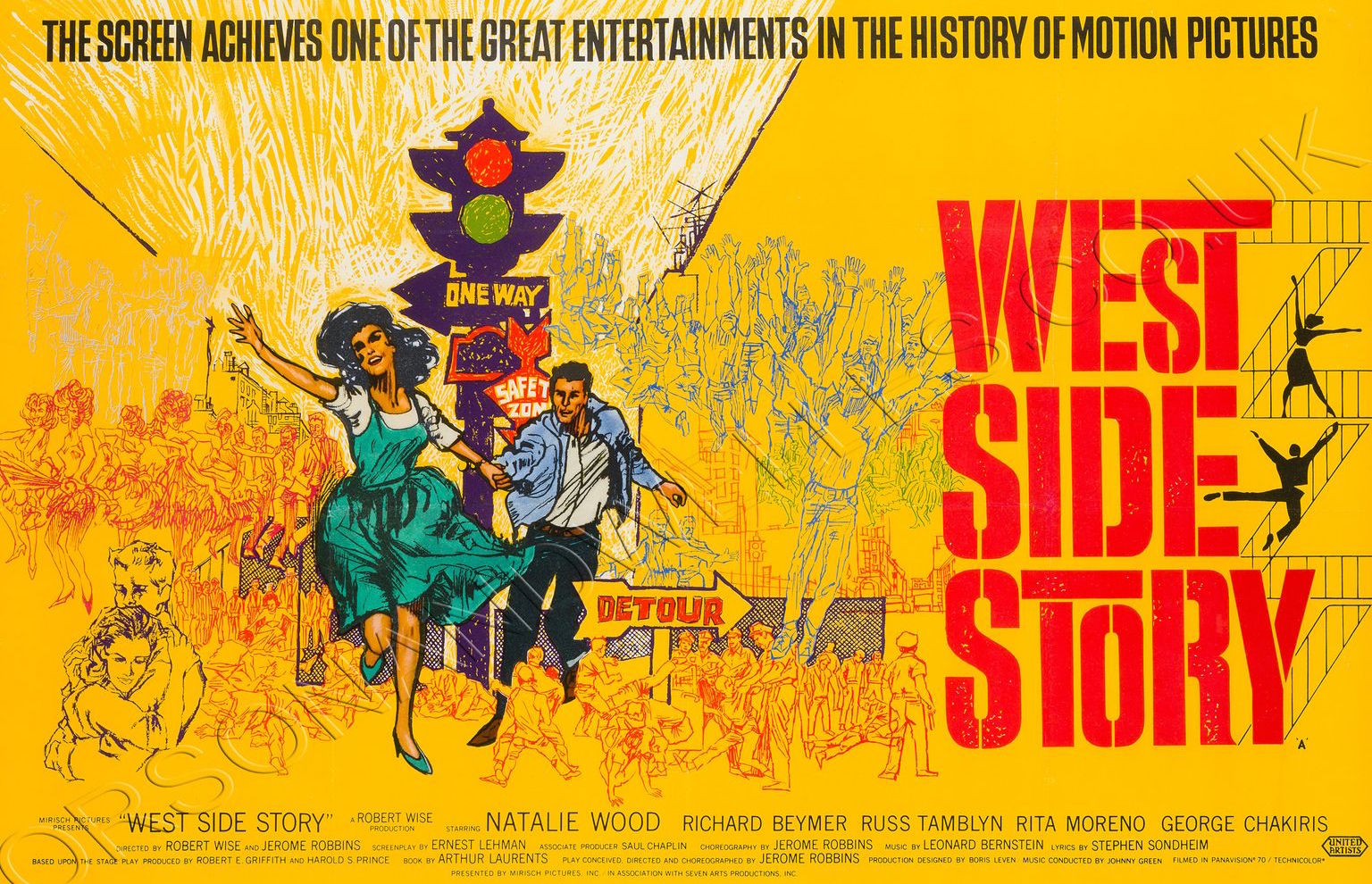
Team Experience is proud to present a three-part retrospective of Leonard Bernstein's masterpiece West Side Story (1961) to honor the composer's centennial. West Side Story premiered on Broadway in September 1957 (though a success, it lost the Best Musical prize to a bigger Broadway hit, The Music Man). Four years later in October 1961 the film version opened in movie theaters, becoming the the top-grossing film of its year, winning 10 Oscars and cementing the musical's place in the cultural consciousness forever.
Part 1 by Lynn Lee
There’s something about West Side Story that inspires obsession. Blending high concept drama and musical theater at its very best, this classic American love story balances delicately between delirious romance and sharp-edged realism until the two collide in a tragedy so gutting it still reduces me to a puddle. What’s more, it’s all transferred so seamlessly to the screen, I’ve yet to see a stage production that equals the power of the film. What’s not to obsess about...

00:25 An opening whistle – the Jets’ call sign – leads into the overture, which like all good overtures previews all the major themes that we’re about to see play out. On screen, all we see is an abstract, stenciled image of New York City, courtesy of Saul Bass. These are pretty static opening titles for Bass, but the shifting background color adds a dynamic element that matches the shifts in the music...
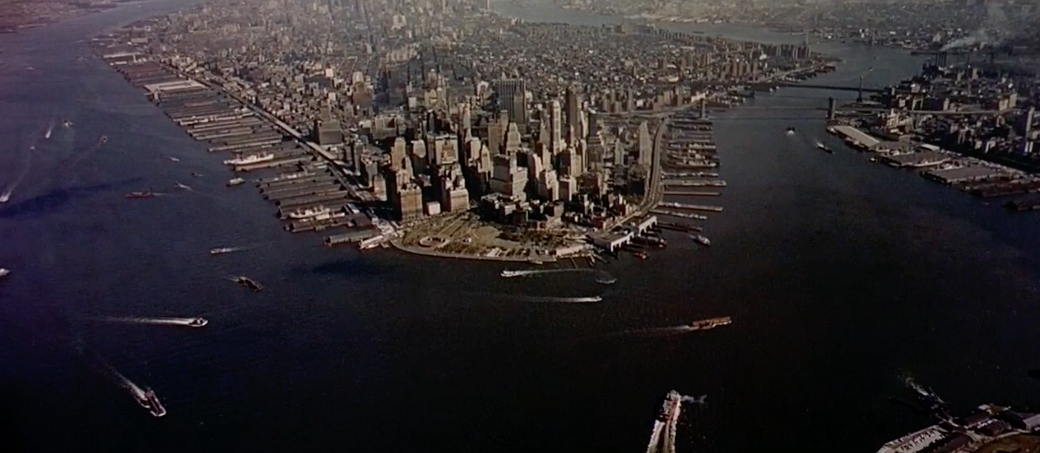
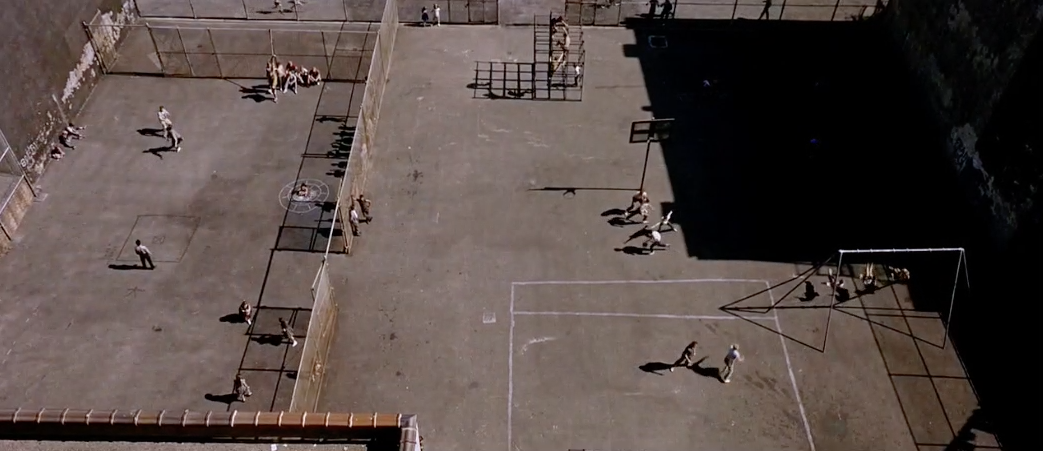
04:45 The camera pulls out as the minimalist image dissolves into the real NYC skyline, then begins moving serenely over the city, high above the towers, rooftops, streets and freeways filled with ant-like cars. The lofty perspective underscores just how small a piece of this city is shortly going to occupy our attention.
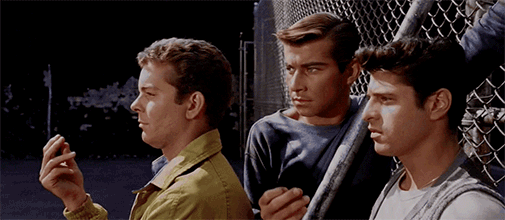
06:30 The camera descends towards a playground, zooming in on the Jets. Our first close-up of them is in profile, still and expressionless. Their seeming repose, though, is undercut by their famously snapping fingers.
06:57 In their opening interactions with other local youths, who immediately defer to them, we see the terms of the Jets’ rule: Respect our authority, and we’ll let you do your thing; disrespect it at your peril. We also see that Riff (Russ Tamblyn) rules this roost with a cool self-possession he rarely loses. Tamblyn was actually on the short list to play Tony, while George Chakiris played Riff (to great acclaim) in the original London cast of the show; but it’s difficult to imagine either as anyone other than the characters they’re now so closely identified with.
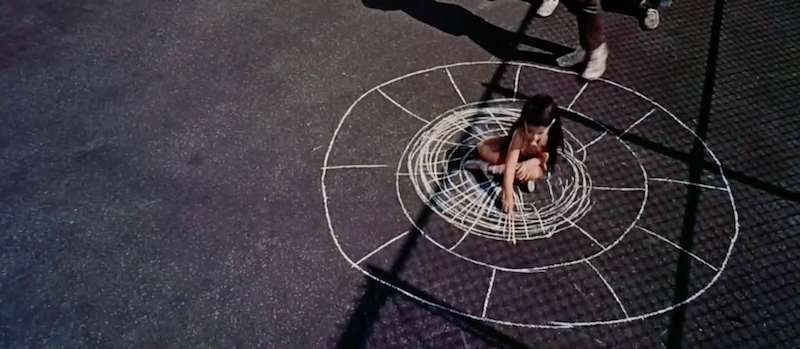
07:22 The overhead shot of this little girl drawing chalk circles makes it look like she’s casting a spell, especially since the circles call to mind events yet to come – the “get together dance,” even the rumble. Maybe that’s why the Jets walk around rather than through her drawing. What does she know that we don’t?
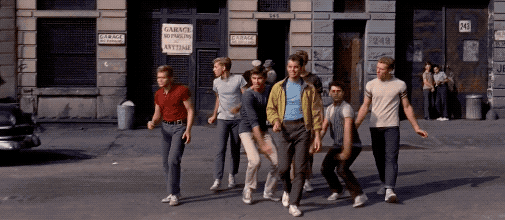
07:58 The Jets begin to stretch their legs in gracefully balletic movements that convey a comfortable sense of dominance; this is their turf.
08:28 …until it isn’t. The reminder: Bernardo (Chakiris), leader of their hated rival, the Puerto Rican Sharks. Most of the Jets sneer and pass on; a couple hang back to follow and harass him. He gazes daggers at them, but alone, he’s powerless.
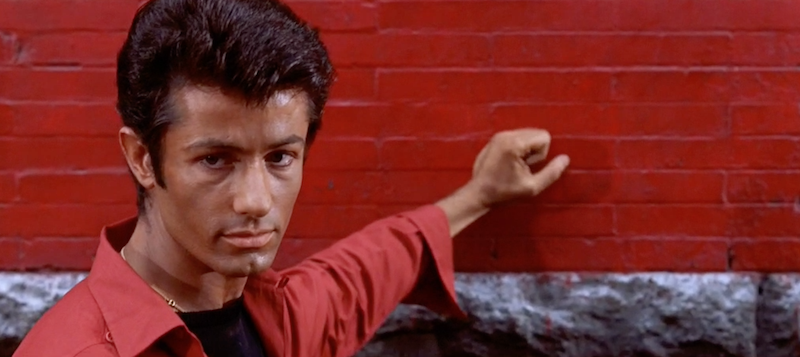
09:12 Bernardo pounds his fist against a wall, the red hue of the brick matching the red of his shirt – and, no doubt, the seething anger in his heart. Can we take a moment to admire how handsome Chakiris is here, brownface makeup notwithstanding, and how graceful his every move? In another version of this story, he’d be the hero.
The next five minutes set forth a brilliantly compact summary of the constantly see-sawing power balance between the Jets and Sharks, the latter continually coming back in gradually increasing numbers. And it’s all conveyed with virtually no dialogue – just music, body language, dance, and other fast-paced movement that the agile camera not only keeps up with but actually enhances. All the skirmishes could be taking place over the same hour, same day or course of days; the point is that the cycle’s clearly been going on for a while.
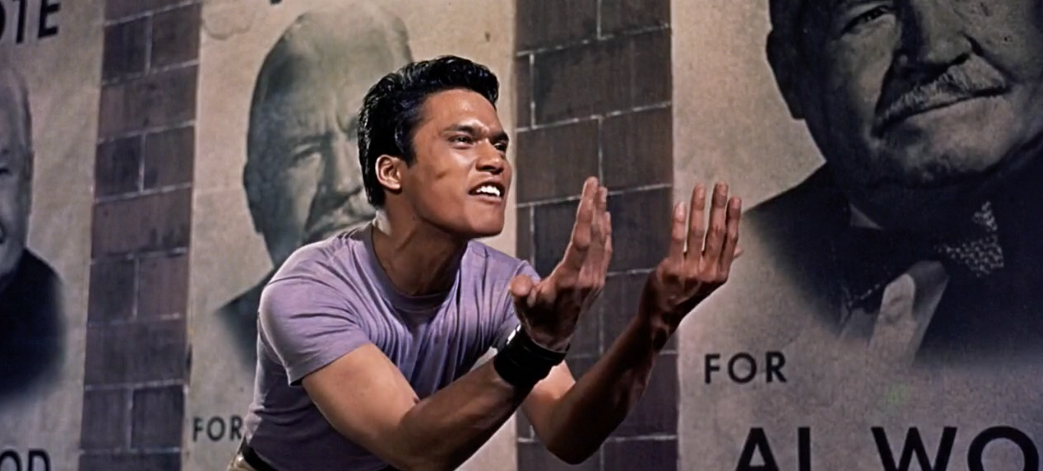
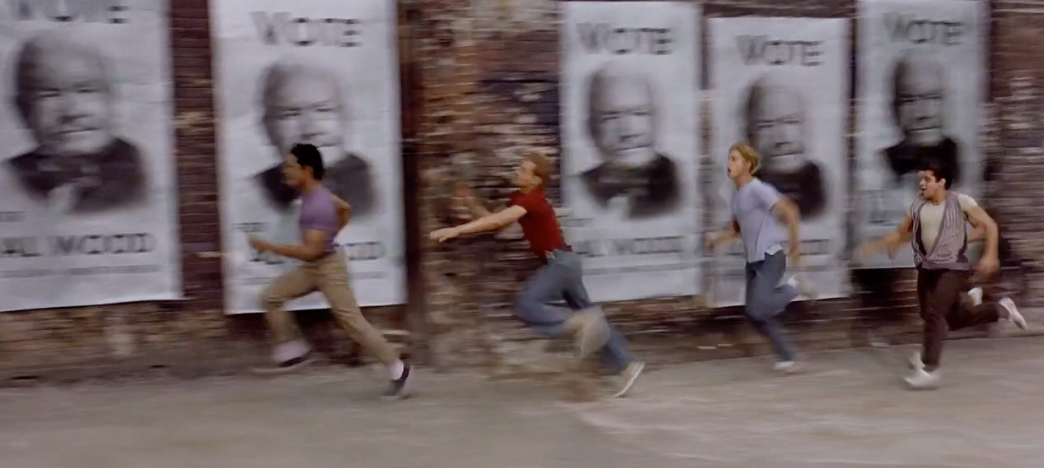
12:07 As the conflict notches up, the music takes on a more urgent and percussive pulse. We see why the Sharks are such a formidable opponent, as they nimbly play divide-and-conquer with the Jets. This is also the most interesting Chino (Jose Devega), Maria’s “intended,” ever gets, as he puckishly dares the Jets to catch him before leading them into a trap.
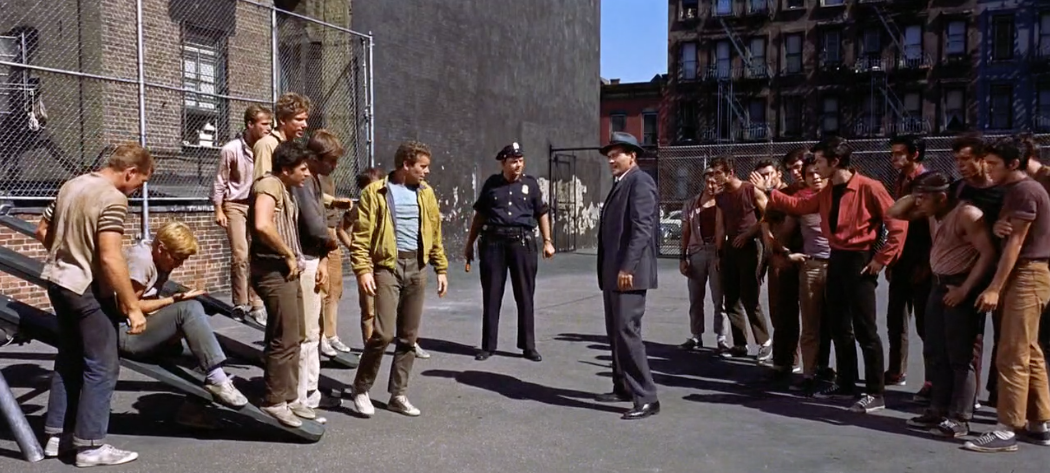
14:42 The first all-out brawl between the two gangs is quickly broken up by Lieutenant Schrank (Simon Oakland) and goonish sergeant Krupke (William Bramley). Unsurprisingly, the one thing that unites the Jets and Sharks is a common enemy, the police.
Bernardo’s ironic trolling runs up against the wall of Schrank’s racism, but the Jets know he’s no friend to them, either, despite his attempts to convince them otherwise. To them, he’s just another threat to their turf.
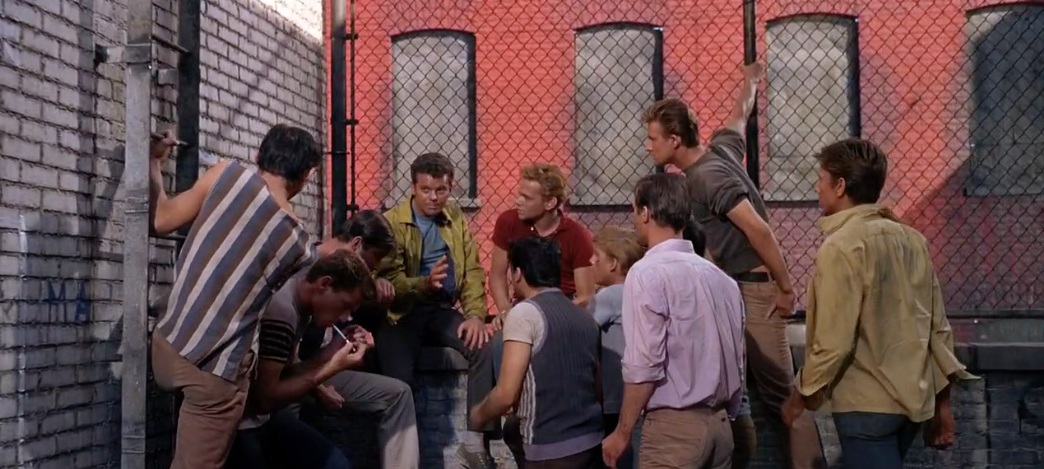
18:30 Who’s ready for a rrrrrumble? Never mind the uncomfortably (and sadly still timely) xenophobic tinge to the Jets’ hostility towards the Sharks (“They keep coming! They’re eating all the food! They’re breathing all the air!”)…to them, it’s a matter of honor.
21:02 The Jets’ song is upbeat yet there’s an undercurrent of pathos to their swagger, since it’s clear being a Jet is the only thing these kids have going for them. That core motivation to be part of a group, a tribe that will protect them and give them prestige, still has relevance today, even if the dated slang and lack of guns feel like a quaint throwback.
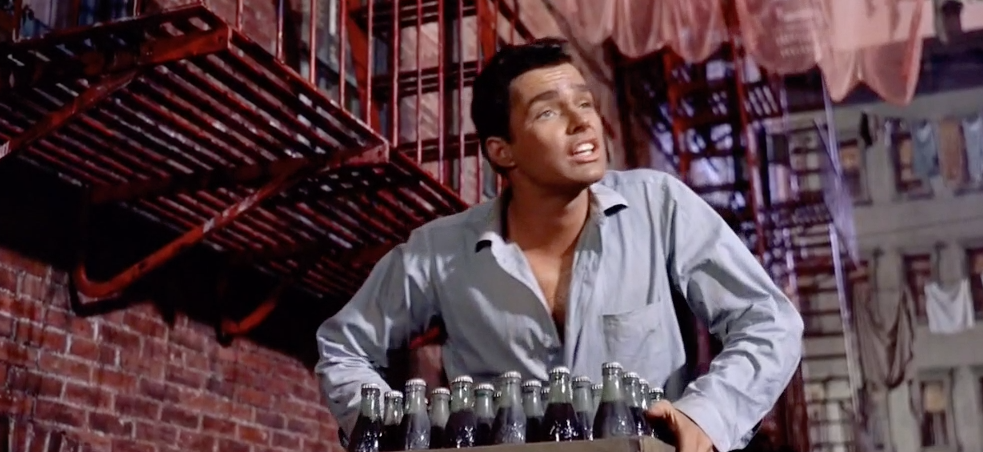
23:03 Our first shot of Tony (Richard Beymer), hefting Coca-Cola bottles, the picture of a clean-cut, good-looking Boy Scout. It’s hard to imagine him as a gang leader or even getting into a fight.
24:08 …until Riff makes the 1950s equivalent of a “yo mama” joke and is promptly overpowered and pinned. It’s just good-natured horseplay, though, that reveals how close these two are; indeed, it’s only Tony’s loyalty to Riff that brings him to the dance where he’ll meet Maria…and, ultimately, to tragedy. “Womb to tomb,” indeed.

26:29 (“Something’s Coming”) Beymer may not have been the first casting choice for Tony, but I can’t think of anyone better suited to the role, even if his singing was dubbed (beautifully, might I add, by Jimmy Bryant). His sweetly open, hopeful face is exactly right for this boy at this moment. The song, too, is gorgeous, capturing the same mood of longing and anticipation, climbing higher and higher while getting softer and softer at the close (a trick we’ll see composer Leonard Bernstein use again in “Maria”), as the camera drifts upward, past the prosaicly drying laundry in the background.
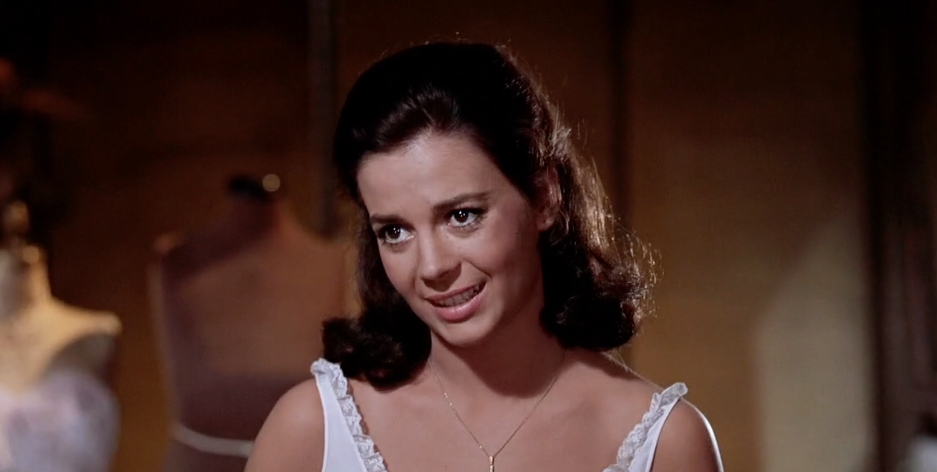 The star doesn't arrive until 28 minutes into the movie. This is the first shot of Natalie Wood
The star doesn't arrive until 28 minutes into the movie. This is the first shot of Natalie Wood
28:50 A smooth dissolve to the dress shop where Anita (Rita Moreno) and Maria (Natalie Wood) work, followed by a pan down to our two lovely ladies. They establish their characters quickly as they bicker over Maria’s dress for the dance. While Maria, who’s basically been cloistered by brother Bernado, cajoles Anita to make the dress sexier, she’s no match for the older and worldlier girl, who easily parries each plea with a killer one-liner.
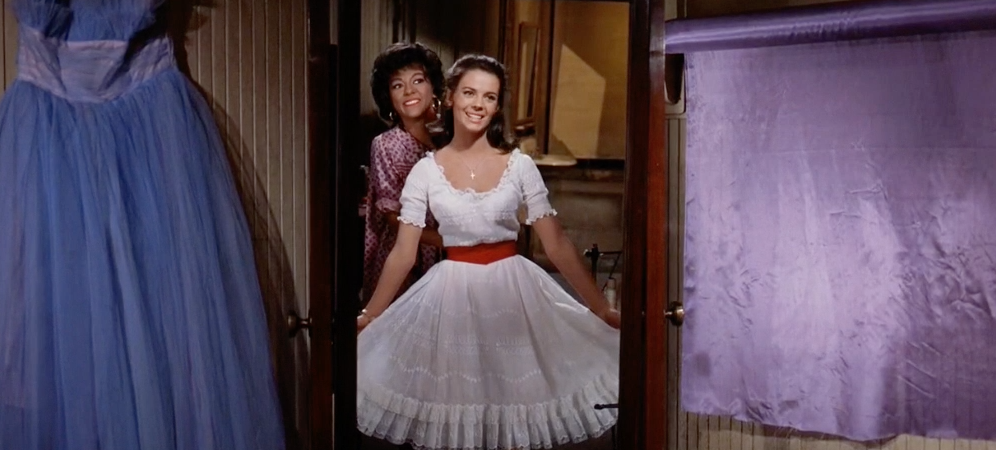
30:27 Of course, once Maria actually sees herself in the dress – a simple white frock, fetchingly set off by a bright red sash – she realizes she looks stunning in it. (Did anyone else yearn for this dress when they were a kid? Although no one will ever wear it better than Natalie Wood.)
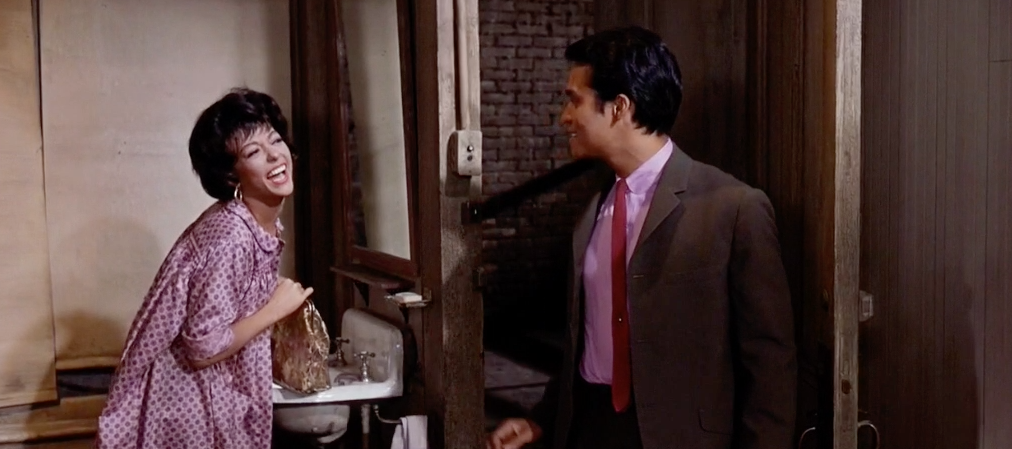
We won't bite you... until we know you better."
31:06 ...Anita definitely gets the best lines in the movie.
31:30 Maria may chafe at Bernardo’s overprotectiveness, but she’s just thankful and excited to be going out at last – even if it’s only a dance at the local gym. Because…
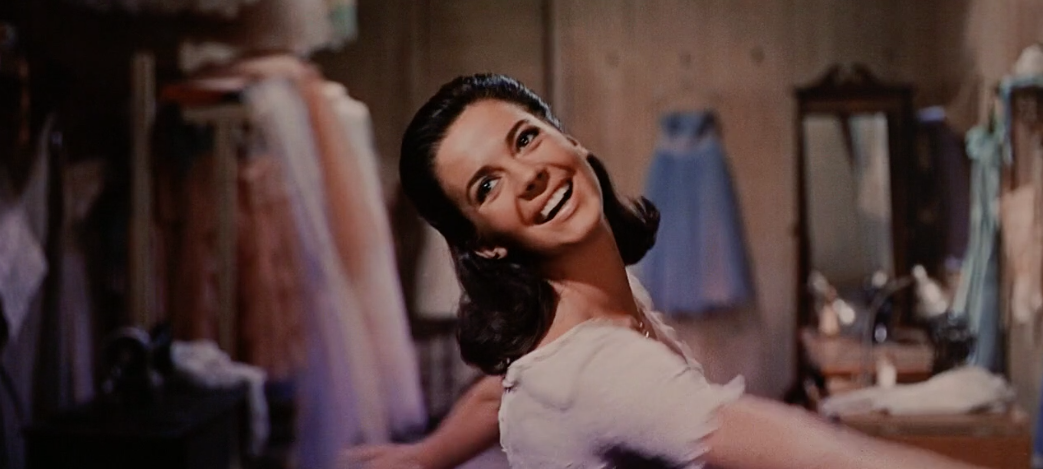
Tonight is the real beginning of my life as a young lady of America!”
And she spins and spins, her spinning blurring into…
32:00 The dance! Jets on one side, Sharks on the other, dancing with a kind of controlled frenzy to big-band jazz. The color composition of this tableau is striking, the more neutral, “cool” colors – blue, white, gray, tan – and tight silhouettes of the Jets’ garb contrasting sharply with the deep red, purple, and pink hues and more flowing lines of the Sharks’.
34:27 Glad Hand (John Astin), sensing an imminent confrontation, has a great idea for a diversion: a get together dance! The mockery is merciless (“Ooh-hoo, it hoyts…it hoyts!”), but I feel for the guy.

35:18 Another stark visual contrast: while Riff summons his girl with his trademark tiny head jerk, Bernardo stretches his arm out towards Anita in a grand, sweeping gesture. Anita circles him just as grandly, almost cutting Graziella with her skirt. Oh, it’s on.
36:26 The “get-together” component of this dance, alas, is a flat failure.
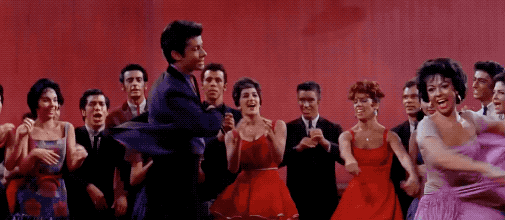
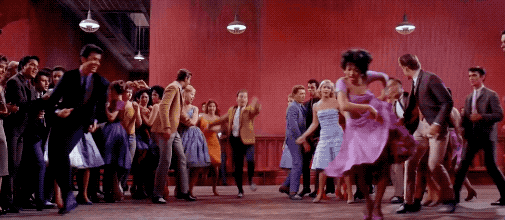
But who cares when the result is the MAMBO! AKA THE GREATEST DANCE-OFF IN THE HISTORY OF MOVIES. In an echo of their stalking and fighting scenes, the gangs jockey for control of the floor, the momentum shifting fluidly back and forth between them. The choreography by Jerome Robbins is genius, allowing each side to infiltrate and take over in turn, before they return to their original half-and-half division of the room. It’s a draw. And yet…while the Jets are skilled dancers and Tamblyn’s tumblin’ is impressive, when it comes to sheer style, plus the combined fire and elegance of Moreno and Chakiris, advantage Sharks.
Meanwhile, Tony’s quietly entered and made his way to the edge of the Jets’ half of the room, exactly opposite Maria on the Sharks’ side.
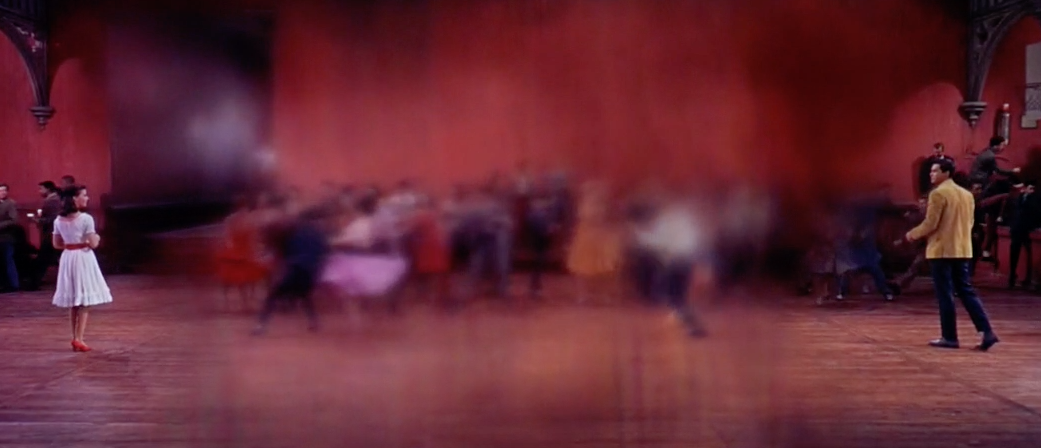
39:06 Maria and Tony first lay eyes on each other just as the music reaches its peak. Has there ever been a more memorable cinematic depiction of love at first sight? Everything else in the room – both the dancers and the music – blurs out as they lock eyes, and everything slows down as they walk towards each other. Their expressions, too, capture that feeling of being hit by a lightning bolt, especially Wood’s: Maria looks bewildered, almost hurt by the realization of how much one can feel in a single moment.
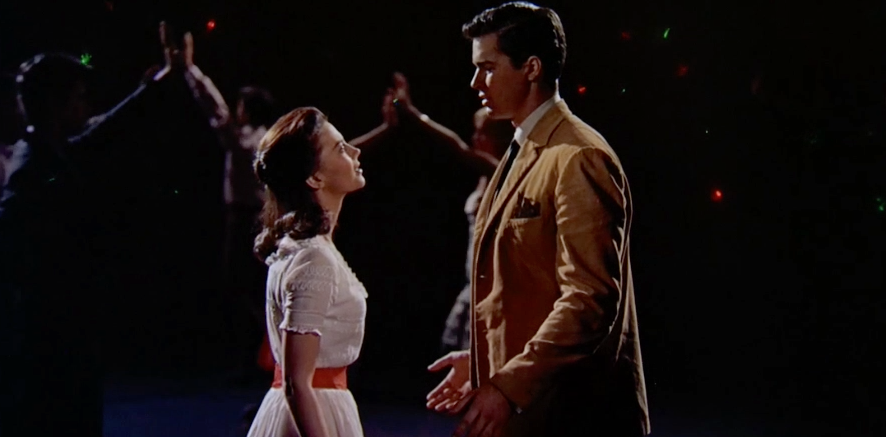
39:40 She’s so tiny standing next to him.
41:45 “I have not yet learned how to joke that way. I think now I never will.” Gets me every time.
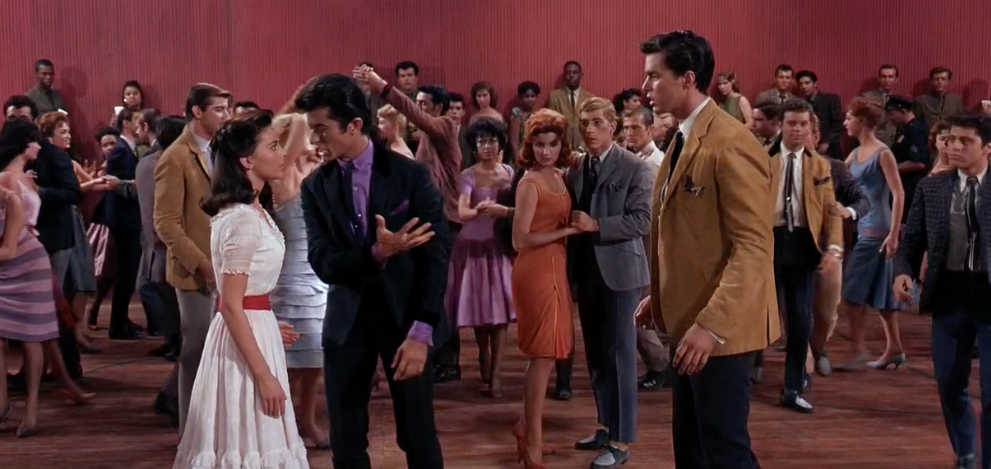
42:25 Bernardo sees them kiss and orders Maria home. You can understand where Bernardo’s coming from here, but yeesh, talk about toxic patriarchal masculinity…
43:44 Thwarted from challenging Tony, he collects himself enough to accept the Jets’ invitation with the silky-smooth faux graciousness, edged with withering contempt, that’s become his MO for dealing with white folks.
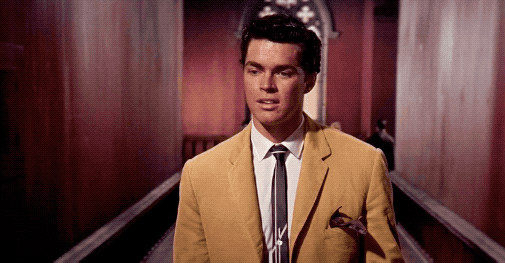
44:18 Even as the war council plans quietly move forward, Tony is blissfully off in a world of his own. As he sings his beatific paean to “Maria,” his surroundings dissolve from the gym to the street to the playground, again evoking the haziness of being in love and not even noticing where you are.
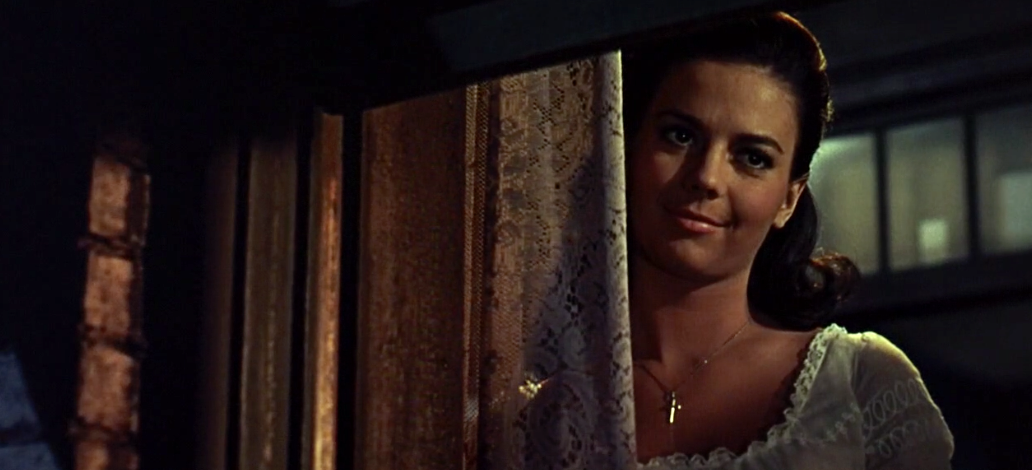
46:57 I love this shot of Maria looking out the window with a Mona Lisa smile, obviously not heeding a word of her big brother’s lecture; we don’t need to hear it, either, as we know by now what he has to say.
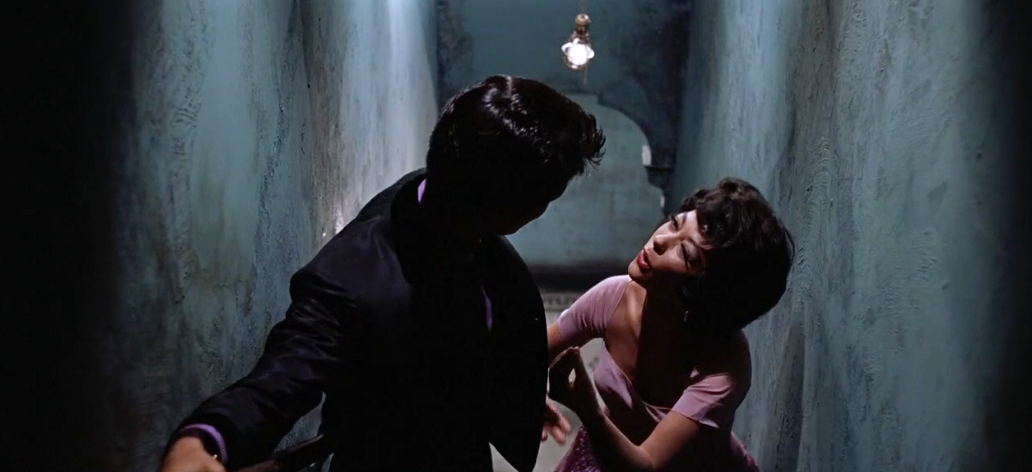
47:21 Anita argues spiritedly if fruitlessly with Bernardo that he should go easier on Maria because she’s in America now. Their flirty verbal sparring segues into a lively debate among all the Sharks and their girlfriends about what it means to be an American. Once again, this entire conversation has way too much contemporary resonance to be merely entertaining.
49:40 But entertaining it sure is. This is the prelude to the hands-down greatest song and set piece of West Side Story, “America.”
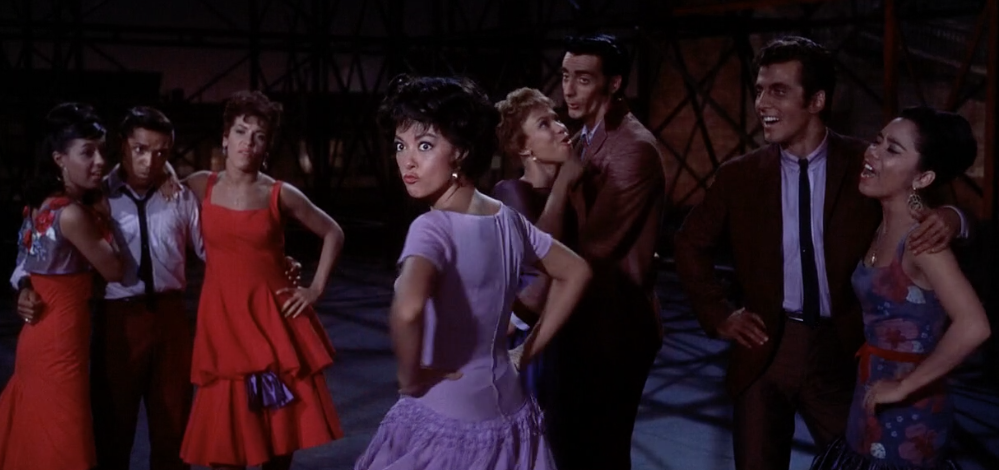
Bernardo: Instead of a shampoo she's been brainwashed. She's given up Puerto Rico and now she's queer for Uncle Sam.
Anita: Oh no. That's not true.
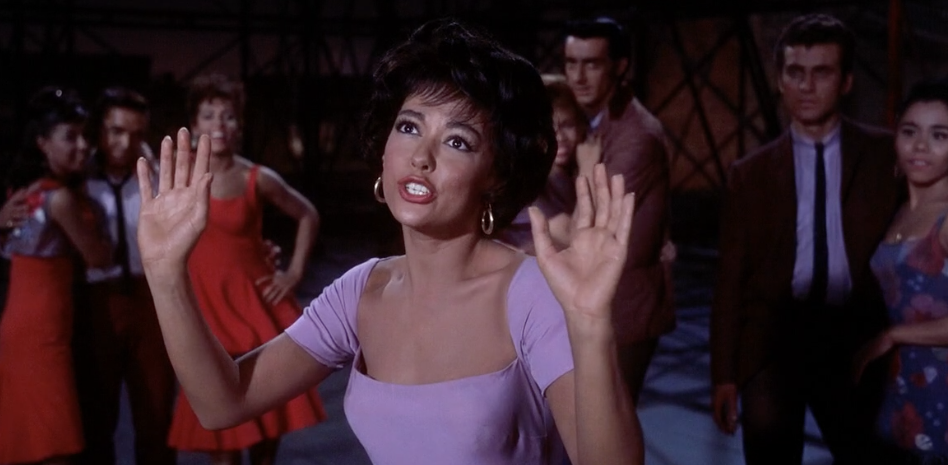
Puerto Rico, my hearts devotion 🎵
Let it sink back in the ocean
Always the hurricanes blowing
Always the population growing
And the money owing
And the sunlight streaming
And the natives steaming
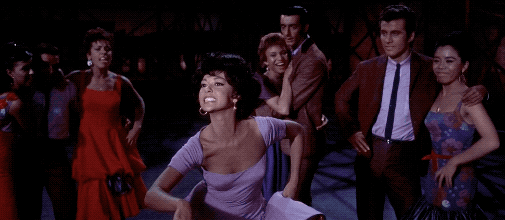
I like the island Manhattan (I know you do!)
Smoke on your pipe, and put that in!
50:20 It's also the literal kick-off to a spectacular showcase for Moreno…